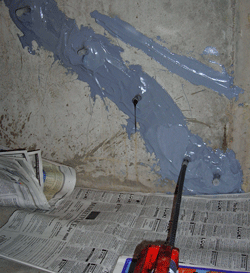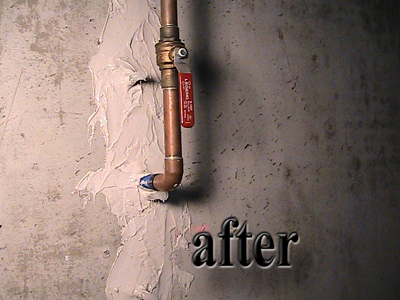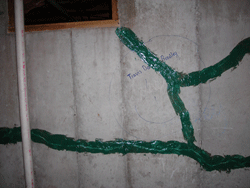I like using epoxy when I want to add tinsel strength to the concrete in addition to waterproofing, however if the foundation is continually settling causing cracks to contract and expand or if a crack is wide and is constantly wet, then I use Polyurethane as it allows for flexibility in foundation movement, unlike epoxy. Also it is activated by water and will expand up to twenty times its volume, filling wide cracks, honey-combed walls, and older foundations. And if a finished look is desired the surface sealant can be removed making the repair hardly noticeable.
Foundations will crack for many reasons.
* improper concrete mix
* improper compaction of fill soil,
* expansive clay soils,
* uneven moisture around the foundation,
* lack of gutters
* poor drainage,
* hydrostatic water pressure.
At this stage of the crack repair the wall has been cleaned and the surface seal applied with the ports attached. Now the injection begins. Notice that I start from the bottom and work my way up, epoxy is oozing out of the port above.(that is supposed to happen)It shows I have good flow. Also notice that my ports are only 6-8 inches apart. This is important so the crack may be filled the entire width of the wall. Cap the port you just injected and work your way up the wall and bingo! a waterproofed crack, not to mention that the tensile strength of the epoxy is three times stronger then concrete so it essentially glues the wall back togeather.
Every home has a waterline coming in. Most of them that come through a foundation wall leak due to hydrostatic pressure. Notice the crack that has developed at the cored hole, this happens because the concrete has been weakened at the hole. Epoxy injection or better yet polyurethane injection is perfect for this repair. It will waterproof around the waterline and fill any voids.
"The two main type of foundation cracks are horizontal and vertical. Horizontal cracks develop because the concrete wall is bowing in, generally due to poor drainage, skimpy workmanship and expansive clay soils. Epoxy injection alone will not solve this problem. Vertical cracks on the other hand are quite often repaired and waterproofed with epoxy injection. I call these cracks "nuisance cracks", these tend to form at the corners of windows or bump downs of the foundation wall and will easily be repaired. Vertical cracks that tend to be wider are usually created due to foundation settlement. They can be epoxied but a more extensive examination is needed for best results."
Notice in the above example(it's hard to see)but there are no ports! all that was done here was surface seal applied but no injection.






